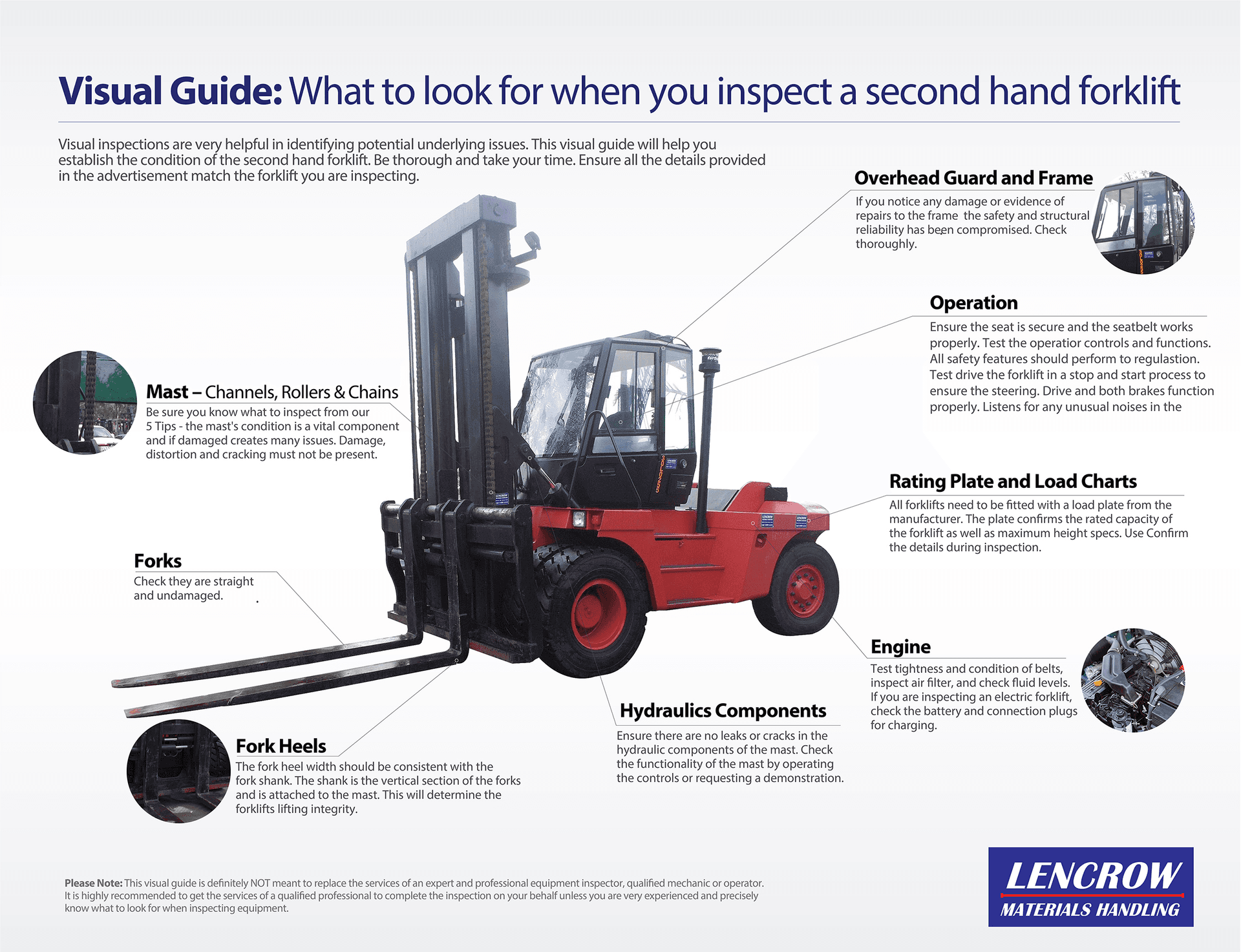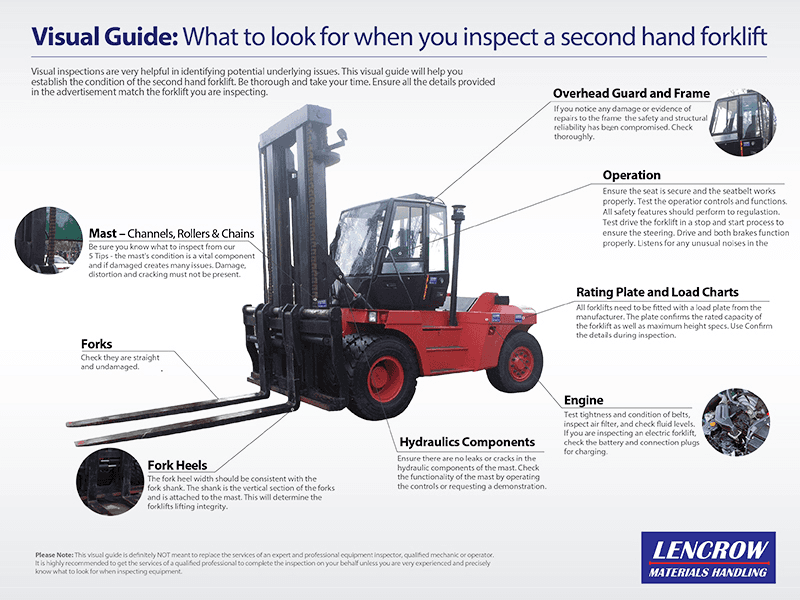Ross Grassick
Forklift Buying Guides
Second Hand Forklift For Sale! What You Should Check Before Buying

5 Tips When Inspecting A Preloved Forklift:
When you begin looking to purchase a product that’s above and beyond the usual expenditure we all tend to consider buying second hand before buying new. It’s not always the case but in many instances a preloved items price tag is easier to digest. If you have been looking and you’ve found the right price how do you know if it’s right purchase for you? We will help you identify what to look for when buying a second hand forklift using a simple 5 step process from the front to the back end.
Second hand forklift purchases can be smart investments and, in some instances the right solution for your handling needs. For example, a forklift might be advertised that includes all the aftermarket features and customisations that you require to manage your materials. These might include specific masts, certain attachments or specialised modifications to suit particular requests. Customising new sales and fitting optional features beyond the standard model can become expensive if you have tailored handling requirements.
So, say you found the right product at the right price – do you know what to look for when inspecting a second hand forklift? Before arranging an inspection make sure you know the key points that determine the suitability of your purchase. For example; what fuel will this forklift require? Ensure you look for a forklift that you can refuel and maintain. Here’s another question for you, what tyres are fitted to the forklift? Consider the surface of your work space and the terrain you will operate the forklift on. Tyres on forklifts are not always interchangeable and these are important points to note when you are researching used forklifts for sale.

Materials handling is a necessary component of daily operations for many industries – whether it’s moving pallets, stacking shipping containers, loading hay bales or lifting heavy items off the back of a truck. If you take a look at our range of used forklifts for sale you will see that one size forklift doesn’t fit every application. The list of options is long and a good starting point is to identify your maximum lifting and capacity needs.
If you aren’t too sure about what product is best for your application, we can give you simple explanations and answers based on your handling requirements and workspace. We endeavour to educate and provide solutions in handling. It’s so important to operate equipment safely in any situation.
If you’re ready to inspect a forklift that’s for sale you can prepare yourself by using these 5 SIMPLE VISUAL INSPECTIONS TIPS. If you come across anything that is damaged, worn or irregular take note of each issue. You will need to review the cost to fix, repair or replace these after the inspection and identifying issues now will save you money later.
1. Forks and Mast
Start your inspection from the front of the forklift. You’ll need to check the forks for any bends, cracks or other kinds of distortion. This can happen if the forks have been overloaded or incorrectly used to load items that shouldn’t have been. If the forks have minor irregularities you are able to have these straightened. We would recommend that if there are irregularities your replace the forks. To lift a load at full capacity, any sign of large and deep cracks ruins the integrity of the masts operability when handling loads.
As you are inspecting the mast check the fork heels as well (refer to visual aid) for any signs of wear. It’s imperative that the thickness of heel forks match closely with the thickness of the upright fork shank (the portion of the fork which is secured to the hook). Once you have established the forks heels condition run your eyes over the hydraulic cylinders that operate the mast. It’s not normal to see leaks from the cylinders but take note that light lubrication is usual so be sure to check the difference. From the cylinders follow your eyes up the mast and check for any cracks or welds. You should also check that the mast pins, tilt and side shift cylinders are secure.
2. Mast Channels, Lift Chains & Cylinders
Carefully inspect the mast channels; look for any welds or cracks which could affect the masts structural reliability. When you’re checking the mast rollers you don’t want to see signs of extreme wear – like a compressed oval shape instead of a round shape. Follow the length of the lift chains after checking the rollers and you hopefully won’t see any missing or damaged anchor pins or links. That’s not a good sign! You should also check the hoses running parallel to the chains for leaks. If you do identify any type of leak it is potentially hydraulic fluid. The channels and chains shouldn’t show any noticeable differences from one side to the other side. Be sure too check that there are no missing or insecure bolts by following the length of chains and hoses to the tilt cylinders that are fixed to the forklift carriage.
If you are happy with the condition of the first two points of inspection this is a good sign. The mast and forks after all are the definitive solution to your handling needs and need to be in good condition.
3. Overhead Guard and Frame
The operator compartment, whether it is a frame or fully enclosed, needs be scrutinised very closely. Ensure that there isn’t bending or damage to the guards. If you see any sign of welding in the overhead and repairs have been made you shouldn’t purchase this particular second hand forklift. This is because it has been structurally compromised and is now unsafe. For forklifts with enclosed cabin you will need to ensure that all the panels and windows are secure and undamaged. You must ensure the next person who operates the forklift can do so safely. Make sure to check the tyres when you check the overhead guards and frame making sure all the bolts are secure.
Be thorough and take as much time as you need – you don’t want any nasty after sales surprises.
4. Operator Controls & General Functions
Get into the forklift operator’s seat and tie up the seat belt. Check the condition of seat belt and that it latches and unlatches correctly. The seat must be secure and set into its position. If the seat is torn you will need to replace it because it can restrict operator’s movement – this is inexpensive to replace but absolutely necessary.
TO OPERATE A FORKLIFT YOU MUST HOLD A CURRENT FORKLIFT OPERATOR LICENSE. If you are going to inspect a forklift and do not hold a license be sure to take someone with you who does to correctly ensure the functions work as they are supposed to.
ALWAYS START THE ENGINE! You want to be certain that the drive, steering and braking operations are good! Listen out for any unusual sounds in the engine. Test the hydraulic operation controls and try each function of the mast – up, down, left, right and tilt. The mast should operate smoothly and if there’s any excessive movement this indicates wearing in the bushes and bearings. In order to test the responsiveness of the steering and braking, drive the forklift in a figure eight pattern, forwards and backwards, stopping and starting it frequently. There are two braking procedures you will need to confirm are working – the service brake & the parking brake. They are located in most cases as separate controls so it’s important that you check both. Ensure the gauges function properly and check all the controls work and match the advertisement – especially all the safety features! WHS does have minimum safety requirements before you can operate a forklift legally, be sure you know what they are and the forklift includes these.
Always check the rating plate and load chart match the advertised specifications. These are placed on every product manufactured by the supplier and must display the correct information for that model. Use this time to make sure the specifications will suit your handling needs.
Please note: It’s recommended that you always get a forklift which has a little higher load bearing capability than what you think you’ll actually require.
If these inspections are confirming that the forklift is in good condition and it meets your materials handling requirements – you’re essentially one step away from finding a preloved forklift at the right price! The final inspection is essential and a costly deal breaker if not inspected closely.
5. Engine Compartment, Counterweights & Exhaust Guard
You would know by now that the engine starts and the forklift operates as it should but always check under the hood. Look over the engine parts making sure there are no cracks, leaks, broken hoses or obvious damage to engine components. Check all the fluids and oils like you would with your car. Take a close look at the condition of the belts ensuring it’s tight and not overly cracked. Check the battery connections and air filters. Other than the fluid checks you just need to visually check the condition of the rest of the engine.
Depending on your fuel choice you will also need to check the features specific to that option. If you are looking at an electric powered unit you will need to check that the charging plugs are in good condition and the battery included is operating (unless advertised otherwise). Batteries usually come with warranties as well so ask if it’s still in the time frame. On units that are fitted with LPG make sure the bracket is secure at the back and the bolts are secure.
While you are at the rear of the forklift inspect the exhaust guard; assess any damage and inspect the rear. The final check is to ensure that the counterweights bolts are firmly in position.
There you have it, the top 5 visual inspection tips to finding a suitable second hand forklift to purchase. Always ask if the forklift has service records and request to see them. You will get a better understanding of forklift by reviewing its service history. If at any point you are unsure seek advice from a qualified technical mechanic. This is a simple visual guide to finding faults but an experienced forklift professional will be able to identify and evaluate the products condition if you are unsure.
Feel free to contact us for advice on any materials handling equipment or services and we will always point you in the right direction to find the right solution for you.
